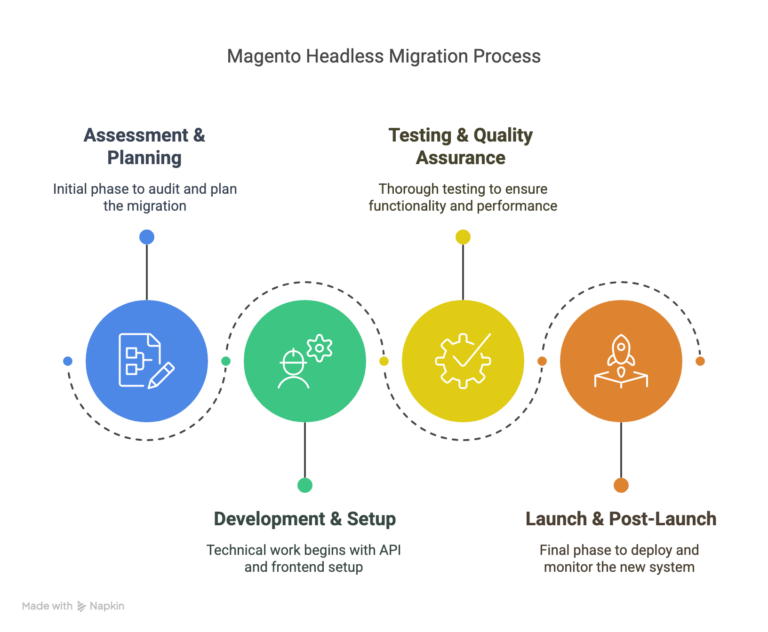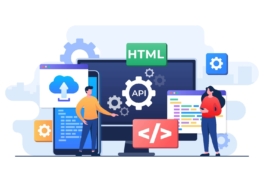Greetings! I'm Aneesh Sreedharan, CEO of 2Hats Logic Solutions. At 2Hats Logic Solutions, we are dedicated to providing technical expertise and resolving your concerns in the world of technology. Our blog page serves as a resource where we share insights and experiences, offering valuable perspectives on your queries.

QUICK SUMMARY
Magento headless migration separates your frontend and backend, giving you greater flexibility, performance, and customer experience control. The process typically takes 3-8 months and involves assessment, development, testing, and launch phases. Common challenges include data synchronization, extension compatibility, and SEO preservation. Not right for every business, but delivers significant ROI for growing mid-to-large retailers.
Are you feeling trapped by your traditional Magento setup? Looking at headless commerce but worried about the migration process?
We’ve been there, navigating the complex world of headless migrations while business owners anxiously wonder if their site will survive the transition.
After helping dozens of businesses successfully migrate from monolithic Magento to headless architecture, we can tell you one thing with certainty: preparation is everything.
In this guide, we’ll explain exactly what to expect during your Magento headless migration, the good, the challenging, and everything in between. There will be no sugar-coating, just practical insights based on real-world experience.
What is Headless Magento Commerce?
Before diving into the migration process, let’s clarify what we mean by “headless Magento.”

Traditional Magento architecture bundles the frontend (what customers see) and backend (the engine that powers your store) together. In contrast, headless Magento decouples these components, giving you:
- A Magento backend that handles product data, inventory, checkout, etc.
- A separate frontend built with modern frameworks like React, Vue, or Next.js
This separation enables incredible flexibility in creating custom shopping experiences across any device or touchpoint.
Why Companies Choose Headless Magento Migration
Before we explore the migration process, let’s understand why businesses make this significant change:
Performance Improvements
- Frontend loads up to 5x faster
- Better Core Web Vitals scores
- Improved mobile experience
Developer Experience
- Modern technology stack
- Easier to find qualified developers
- Faster implementation of new features
Customer Experience
- Fully customizable UI/UX
- Consistent experiences across all touchpoints
- Progressive enhancement capabilities
Business Benefits
- Higher conversion rates (we’ve seen 15-30% improvements)
- Lower bounce rates
- Better SEO performance
The Magento Headless Migration Process: Step by Step
Let’s break down what your migration journey typically looks like:

Phase 1: Assessment & Planning
During this crucial first phase, expect to:
- Audit your current Magento setup
- Catalog structure analysis
- Custom extension inventory
- Integration mapping
- Define your migration strategy
- Big bang vs. phased approach
- Timeline development
- Resource allocation
- Choose your frontend technology
- Framework selection (React, Vue, Next.js, etc.)
- Headless CMS considerations
- Performance requirements
- Map API requirements
- Identify needed endpoints
- Define data structures
- Plan authentication methods
The planning phase is where migrations succeed or fail. We spend extra time here because it pays dividends throughout the project. – Indrajith CTO at 2HatsLogic
Phase 2: Development & Setup (8-16 weeks)
This is where the technical work begins:
- API Configuration
- Setting up Magento API endpoints
- Implementing GraphQL if needed
- Establishing authentication protocols
- Frontend Development
- Building the presentation layer
- Creating a component library
- Implementing responsive design
- Integration Implementation
- Connecting payment gateways
- Setting up shipping calculators
- Integrating third-party services
- Custom Feature Development
- Rebuilding unique functionality
- Implementing advanced search
- Creating custom checkout flows
Phase 3: Testing & Quality Assurance (3-4 weeks)
No migration is complete without thorough testing:
- Functional Testing
- Product browsing
- Cart and checkout functionality
- User account features
- Performance Testing
- Page load speeds
- API response times
- Stress testing
- Cross-browser/Cross-device Testing
- Desktop, tablet, mobile verification
- Browser compatibility checks
- SEO Validation
- URL structure verification
- Schema implementation
- Redirect mapping
Phase 4: Launch & Post-Launch (2-4 weeks)
The moment of truth:
- Pre-launch Checklist
- Final UAT (User Acceptance Testing)
- DNS and SSL configuration
- Analytics setup
- Deployment Strategy
- Traffic routing plan
- Rollback procedures
- Cache warming
- Post-launch Monitoring
- Performance tracking
- Error logging
- User behavior analysis
- Optimization Phase
- Addressing edge cases
- Performance fine-tuning
- Feature enhancements
Pro Tip: Create a dedicated “war room” chat channel for the first 48 hours after launch where team members can quickly address any issues that arise.
Common Challenges During Magento Headless Migration
Let’s be honest, migrations aren’t always smooth sailing. Here are the challenges we commonly encounter and how to address them:
Data Synchronization Issues
Challenge: Keeping product data, inventory, and customer information in sync between systems.
Solution: Implement robust webhook systems and queue management to ensure reliable data flow. We typically use message queues like RabbitMQ to handle high volumes of data updates.
Custom Extension Compatibility
Challenge: Many traditional Magento extensions don’t work in a headless environment.
Solution: Map extension functionality early and plan for custom API development or replacements. Sometimes this means building lightweight microservices to replace extension functionality.
SEO Preservation
Challenge: Maintaining search rankings during architectural changes.
Solution: Implement comprehensive redirect mapping and ensure proper metadata transfer. We use specialized crawling tools to catalog all indexed URLs before migration.
Performance Optimization
Challenge: Achieving the full performance benefits of headless architecture.
Solution: Implement aggressive caching strategies, lazy loading, and code splitting. Our frontend implementations typically use static site generation where possible, combined with incremental static regeneration.
Cost Considerations for Magento Headless Migration
Budgeting realistically is crucial for migration success. Here’s what to expect:
| Cost Category | Description | Approximate Range |
| Development | Frontend building, API work | $50,000 – $250,000+ |
| Design | UX/UI design for new frontend | $10,000 – $50,000 |
| QA & Testing | Cross-platform testing | $5,000 – $25,000 |
| Training | Team education on the new system | $2,000 – $10,000 |
| Ongoing Maintenance | Post-launch support | $2,000 – $10,000/month |
Variables that significantly impact cost include:
- Store complexity and size
- Custom feature requirements
- Integration needs
- Timeline constraints
Want a personalized cost breakdown for your headless migration?
Is Magento Headless Migration Right for Your Business?
While headless commerce offers tremendous benefits, it’s not the right solution for every business. Consider these factors:
Good candidates for headless migration:
- Mid-to-large sized businesses
- Companies with multiple sales channels
- Organizations with development resources
- Businesses focused on digital growth
- Retailers with complex customer journeys
May want to reconsider headless:
- Very small businesses with limited budgets
- Companies with minimal digital presence
- Organizations with very simple product offerings
- Businesses without technical resources
Ready to Begin Your Headless Magento Journey?
Transitioning to headless Magento isn’t just a technical upgrade it’s a business transformation that positions you for future growth and exceptional customer experiences.
At 2HatsLogic, we’ve guided dozens of businesses through successful headless migrations, combining technical expertise with business strategy to ensure your investment delivers measurable returns.
Whether you’re just exploring headless commerce or ready to start your migration planning, our team can help you navigate the process with confidence.
Contact us today for a free consultation and discover how we can make your Magento headless migration smooth, efficient, and profitable.
FAQ
How long does a typical Magento headless migration take?
Most projects take between 3-8 months, depending on complexity, though we've completed simpler migrations in as little as 2 months.
Will my SEO be affected by the migration?
With proper planning, your SEO should remain intact or improve. We implement comprehensive redirect strategies and maintain metadata integrity throughout the process.
Can I migrate in phases, or is it all-or-nothing?
Phased approaches work well! Many clients start with their product catalog, then progressively move to checkout, account management, and other features.
Table of contents
- What is Headless Magento Commerce?
- Why Companies Choose Headless Magento Migration
- The Magento Headless Migration Process: Step by Step
- Common Challenges During Magento Headless Migration
- Cost Considerations for Magento Headless Migration
- Is Magento Headless Migration Right for Your Business?
- Ready to Begin Your Headless Magento Journey?

Related Articles






